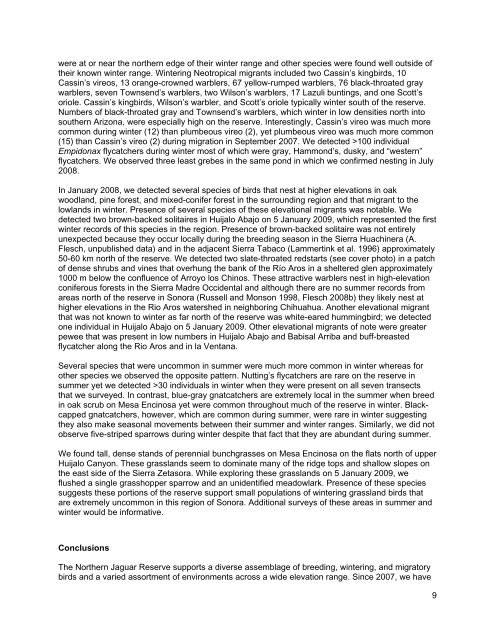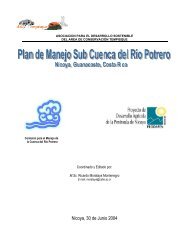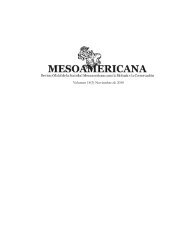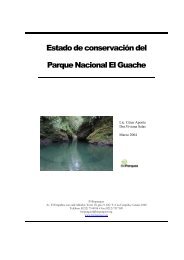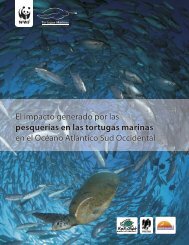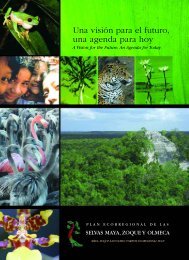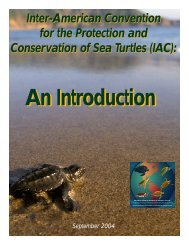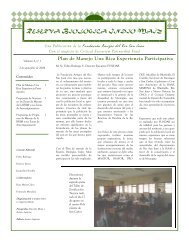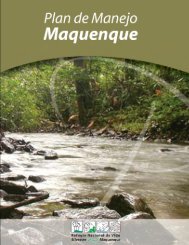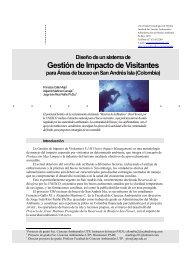Breeding, Migratory, and Wintering Birds of the Northern ... - Eco-Index
Breeding, Migratory, and Wintering Birds of the Northern ... - Eco-Index
Breeding, Migratory, and Wintering Birds of the Northern ... - Eco-Index
Create successful ePaper yourself
Turn your PDF publications into a flip-book with our unique Google optimized e-Paper software.
were at or near <strong>the</strong> nor<strong>the</strong>rn edge <strong>of</strong> <strong>the</strong>ir winter range <strong>and</strong> o<strong>the</strong>r species were found well outside <strong>of</strong><strong>the</strong>ir known winter range. <strong>Wintering</strong> Neotropical migrants included two Cassin’s kingbirds, 10Cassin’s vireos, 13 orange-crowned warblers, 67 yellow-rumped warblers, 76 black-throated graywarblers, seven Townsend’s warblers, two Wilson’s warblers, 17 Lazuli buntings, <strong>and</strong> one Scott’soriole. Cassin’s kingbirds, Wilson’s warbler, <strong>and</strong> Scott’s oriole typically winter south <strong>of</strong> <strong>the</strong> reserve.Numbers <strong>of</strong> black-throated gray <strong>and</strong> Townsend’s warblers, which winter in low densities north intosou<strong>the</strong>rn Arizona, were especially high on <strong>the</strong> reserve. Interestingly, Cassin’s vireo was much morecommon during winter (12) than plumbeous vireo (2), yet plumbeous vireo was much more common(15) than Cassin’s vireo (2) during migration in September 2007. We detected >100 individualEmpidonax flycatchers during winter most <strong>of</strong> which were gray, Hammond’s, dusky, <strong>and</strong> “western”flycatchers. We observed three least grebes in <strong>the</strong> same pond in which we confirmed nesting in July2008.In January 2008, we detected several species <strong>of</strong> birds that nest at higher elevations in oakwoodl<strong>and</strong>, pine forest, <strong>and</strong> mixed-conifer forest in <strong>the</strong> surrounding region <strong>and</strong> that migrant to <strong>the</strong>lowl<strong>and</strong>s in winter. Presence <strong>of</strong> several species <strong>of</strong> <strong>the</strong>se elevational migrants was notable. Wedetected two brown-backed solitaires in Huijalo Abajo on 5 January 2009, which represented <strong>the</strong> firstwinter records <strong>of</strong> this species in <strong>the</strong> region. Presence <strong>of</strong> brown-backed solitaire was not entirelyunexpected because <strong>the</strong>y occur locally during <strong>the</strong> breeding season in <strong>the</strong> Sierra Huachinera (A.Flesch, unpublished data) <strong>and</strong> in <strong>the</strong> adjacent Sierra Tabaco (Lammertink et al. 1996) approximately50-60 km north <strong>of</strong> <strong>the</strong> reserve. We detected two slate-throated redstarts (see cover photo) in a patch<strong>of</strong> dense shrubs <strong>and</strong> vines that overhung <strong>the</strong> bank <strong>of</strong> <strong>the</strong> Río Aros in a sheltered glen approximately1000 m below <strong>the</strong> confluence <strong>of</strong> Arroyo los Chinos. These attractive warblers nest in high-elevationconiferous forests in <strong>the</strong> Sierra Madre Occidental <strong>and</strong> although <strong>the</strong>re are no summer records fromareas north <strong>of</strong> <strong>the</strong> reserve in Sonora (Russell <strong>and</strong> Monson 1998, Flesch 2008b) <strong>the</strong>y likely nest athigher elevations in <strong>the</strong> Rio Aros watershed in neighboring Chihuahua. Ano<strong>the</strong>r elevational migrantthat was not known to winter as far north <strong>of</strong> <strong>the</strong> reserve was white-eared hummingbird; we detectedone individual in Huijalo Abajo on 5 January 2009. O<strong>the</strong>r elevational migrants <strong>of</strong> note were greaterpewee that was present in low numbers in Huijalo Abajo <strong>and</strong> Babisal Arriba <strong>and</strong> buff-breastedflycatcher along <strong>the</strong> Rio Aros <strong>and</strong> in la Ventana.Several species that were uncommon in summer were much more common in winter whereas foro<strong>the</strong>r species we observed <strong>the</strong> opposite pattern. Nutting’s flycatchers are rare on <strong>the</strong> reserve insummer yet we detected >30 individuals in winter when <strong>the</strong>y were present on all seven transectsthat we surveyed. In contrast, blue-gray gnatcatchers are extremely local in <strong>the</strong> summer when breedin oak scrub on Mesa Encinosa yet were common throughout much <strong>of</strong> <strong>the</strong> reserve in winter. Blackcappedgnatcatchers, however, which are common during summer, were rare in winter suggesting<strong>the</strong>y also make seasonal movements between <strong>the</strong>ir summer <strong>and</strong> winter ranges. Similarly, we did notobserve five-striped sparrows during winter despite that fact that <strong>the</strong>y are abundant during summer.We found tall, dense st<strong>and</strong>s <strong>of</strong> perennial bunchgrasses on Mesa Encinosa on <strong>the</strong> flats north <strong>of</strong> upperHuijalo Canyon. These grassl<strong>and</strong>s seem to dominate many <strong>of</strong> <strong>the</strong> ridge tops <strong>and</strong> shallow slopes on<strong>the</strong> east side <strong>of</strong> <strong>the</strong> Sierra Zetasora. While exploring <strong>the</strong>se grassl<strong>and</strong>s on 5 January 2009, weflushed a single grasshopper sparrow <strong>and</strong> an unidentified meadowlark. Presence <strong>of</strong> <strong>the</strong>se speciessuggests <strong>the</strong>se portions <strong>of</strong> <strong>the</strong> reserve support small populations <strong>of</strong> wintering grassl<strong>and</strong> birds thatare extremely uncommon in this region <strong>of</strong> Sonora. Additional surveys <strong>of</strong> <strong>the</strong>se areas in summer <strong>and</strong>winter would be informative.ConclusionsThe Nor<strong>the</strong>rn Jaguar Reserve supports a diverse assemblage <strong>of</strong> breeding, wintering, <strong>and</strong> migratorybirds <strong>and</strong> a varied assortment <strong>of</strong> environments across a wide elevation range. Since 2007, we have9


